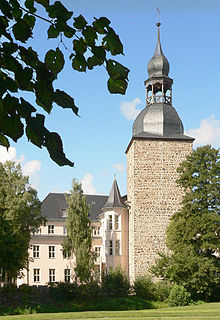Aga vom Hagen
Augusta ("Aga") Clara Elisabeth Countess von Hagen (born January 2, 1872 in Möckern ; † April 8, 1949 in Schlieben ) was a German painter , author and art patron .
Life
It dates from the raised into the count conditions eichsfeldischen noble family from Hagen, daughter of Hilmar Friedrich Anton Graf is born from Hagen and his wife Martha von der Schulenburg born and in 1872 at Castle Möckern. There she grew up with six siblings and received private lessons. Countess Aga vom Hagen studied painting with Reinhold Lepsius and Lovis Corinth as well as other well-known artists of their time. She lived in Paris from 1904 to perfect her artistic skills as a painter at the art academy there. Claudio Castelucho was one of her teachers there . She became long-term friends with Max Beckmann , Alfred Kerr and Carl Sternheim .
After returning to Germany, vom Hagen settled in Berlin, maintained a house there and promoted contemporary artists. Max Beckmann portrayed them in 1908 and captured them a year later in his work The Resurrection .
At the beginning of the First World War in 1914, Aga vom Hagen volunteered for the medical service. She was deployed in hospitals on the Western Front. It was there two years later in Brussels that she met the writer Carl Einstein , who had been married to Maria Ramm since 1913 and had a young daughter. A love relationship developed with him. The playwright Carl Sternheim immortalized this cohabitation in his story Ulrike , published in Leipzig in 1918 .
After the end of the war, Aga von Hagen became a member of the KPD and was therefore nicknamed The Red Countess . During this time, Aga vom Hagen lived with Carl Einstein at Matthäikirchstrasse 14 in Berlin-Frohnau , whose marriage was only divorced in 1923. After Einstein met the Frankfurt banker's daughter Tony Simon-Wolfskehl at the end of 1922 and wanted to marry her, Aga von Hagen stayed more and more often at Möckern Castle with the family of her brother Rüdiger Graf von Hagen. She was socially committed, wrote poetry and a play, and devoted herself to painting. She later moved permanently to Möckern. There she experienced the occupation in May 1945 and the expropriation of her parents' property through the land reform in September 1945.
In 1946 Aga vom Hagen was arrested and taken to the Soviet special camp in Schlieben . She was forbidden to return home and died in this camp in 1949.
Works
- The dog breeds. A handbook for dog lovers and breeders , Potsdam, Athenaion, 1st edition, 1935; 8th, revised and expanded edition 1943.
reception
Angelika Gräfin vom Hagen and Stefanie Fabian stated in 2019:
"An intensive scientific research into the life and work of A. vom Hagen is still pending [...]"
Honors
In February 2013, after 75 years, parts of Aga Gräfin von Hagen's play Gefecht bei Möckern from 1938 were publicly performed again in Möckern .
literature
- Angelika Countess of Hagen / Stefanie Fabian: Hagen, Augusta Clara Elisabeth (Aga) Countess of . In: Eva Labouvie (Ed.): Women in Saxony-Anhalt . 2 A biographical-bibliographical lexicon from the 19th century to 1945. Böhlau, Köln u. a. 2019, ISBN 978-3-412-51145-6 , pp. 189-192 .
Web links
Individual evidence
- ^ Portrait of Augusta Gräfin vom Hagen by Max Beckmann, 1908, in the Neue Meister gallery in Dresden .
- ^ Liliane Meffre: Carl Einstein, 1885–1940. Itinéraires d'une pensée modern. Presses de l'université de Paris-Sorbonne, Paris 2002, p. 202.
- ↑ Berliner Adreßbuch , 1929, p. 909.
- ↑ A portrait of the poet and art historian Carl Einstein. In: Die Zeit of December 11, 1992
- ↑ For the statement that the expropriation already took place in May 1945 on SMAD orders, cf. here: Hans Dietrich Graf vom Hagen: Hagen, Adelbert Wilhelm Hilmar Rüdiger Graf vom could not find any evidence.
- ↑ Still a crowd puller even after 75 years. In: Volksstimme, Burg edition, from February 18, 2013
| personal data | |
|---|---|
| SURNAME | Vom Hagen, Aga |
| ALTERNATIVE NAMES | Vom Hagen, Augusta Clara Elisabeth Countess (full name) |
| BRIEF DESCRIPTION | German painter, author and patron of the arts |
| DATE OF BIRTH | January 2, 1872 |
| PLACE OF BIRTH | Moan |
| DATE OF DEATH | April 8, 1949 |
| Place of death | Close |
